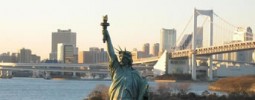Varna (Варна) is the largest city and seaside resort on the Bulgarian Black Sea Coast and in Northern Bulgaria, as well the 3rd largest city in Bulgaria after it’s capital Sofia and Plovdiv. Varna is also known as summer capital of Bulgaria, it’s a popular tourist destination, business and university center, seaport, and headquarters of the Bulgarian Navy. As of latest measurement the city of Varna has a population of 360 thousand people.
Besides the fact Varna is the 3rd largest city in the country, it’s also the most popular tourist destination for locals and foreigners. Varna is known as Bulgaria’s Seaside Capital and Pearl of the Black Sea Coast. The city is arranged in tiers along the Varna Bay, which has popular beach resorts and shops, restaurants and lounges on the boulevard. Further more it offers art galleries, museums, historical buildings and cultural entertainment making it an all year round travel destination.
Beyond the beach areas there are incredible treasures spanning back from Stone Age, Thracian, Classical and Mediaeval times. Cultural and historical sightseeing in Varna is therefore not a problem. Within city center there’s cathedrals, temples and chapels of multiple centuries ago. Simply walking to the streets is sightseeing itself, try to enjoy its ambiance while there.
Travelers arriving in Varna through Varna Aiport can make use of bus and taxi to the city. A valid passport is required to enter Varna, there are no visa requirements. Your stay is valid for up to 90 days. Varna is an important railway station which connects the city to other cities, including capital Sofia. The city has regular bus transport to move around. Most sights in the center are walkable.
Plovdiv (Пловдив) is the second largest city in Bulgaria after it’s capital Sofia. Plovdiv is also the administrative center of the Plovdiv Province as well two other municipalities named Maritsa and Rodopi situated in southern Bulgaria. Plovdiv is also as important transport, cultural, education and economic center. As of latest measurement the city has a population of 380 thousand people.
It’s one of the globe’s oldest continuously inhabited cities as Plovdiv’s history goes back over 6 thousand years. Plovdiv is located in the large plain between the Rhodope Mountains in the south Bulgaria, and the Balkan Range, or Old Mountains (Stara Planina) which runs through center Bulgaria. The Maritsa River flows southeast of the city, leading to the Greece and Turkey border which situated by the Aegean Sea.
The main areas, city center and downtown are road blocked for cars, as well that the city size is excellent for getting round on foot. It offers a good collection of historical Bulgarian buildings in the forms of museums, restaurants, hotels and several parks. Wander through the narrow cobblestone streets to visit the centuries old St. Marina Church with it’s one of a kind wooden tower and a mosque from the Ottoman Empire nearby the old town center. For those who need to travel further it’s advised to use a taxi. When traveling with more than 3 people it’s cheaper to use a private taxi than a public bus, when you order a taxi directly from the company’s hot line.
Travelers to Plovdiv require a valid passport, but don’t need a visa. Your stay is valid for up to 90 days. Plovdiv is an important railway station which connects the city to other cities, including capital Sofia. The city has regular bus transport to move around. Most sights in the center are walkable.
Burgas, or Bourgas, is the second largest city in Bulgaria. It is located on the Bulgarian Black Sea Coast near the Burgas Bay, so it is referred to as a seaside resort. However the city also is an industrial center and main port. The city is surrounded by three lakes, Vaya (the Burgas) lake, Atanaskovsko lake and Mandrensko lake. Burgas has a population of almost 300 thousand people.
From Burgas it is easy to explore the southern coast of Bulgaria and its beach resorts and more historic towns, such as Nesebar and Sozopol. The city itself also offers enough things to do and see. It has luxury holiday resorts as well as campsites on beaches for nature lovers. Burgas has an uncrowded beach and bossy sea side park, the Maritime Park. The city has a nightlife with bars, clubs and theaters.
The city was founded by Greek colonists who named the town Pyrgos. The old town shows some of its history as well as the Archaeological Museum. Other museums are the Ethnographic Museum, the Burgas Regional Historical Museum and the Museum of Nature and Science. If you like art, the city has one of the oldest art galleries in the country in the form of the Burgas Art Gallery, located in a former Jewish Synagogue.
Travelers to Burgas need a valid passport. A visa isn’t necessary for a stay up to 90 days. The best time to travel is in the summer, when the city is most lively. There are more activities to do, surfing and kite-surfing for instance. Be aware of pick pocketing, beggars who follow you around, scam-taxi drivers and drunk people during summer months.
Vratza, or also spelled as Vratsa, is a city in the northwest of Bulgaria. It is located at the foothills of the Vrachanski Balkan Mountain. The Leva River runs through the city. It is a commercial, administrative, crafts, tourist and cultural center. It has a population of almost 69 thousand people. Vratza has a rich history and it is one of the most picturesque cities in Bulgaria.
Vratza attracts tourists with its wealth of history and culture. The Vrachaski Balkan offers many active activities such as hunting and fishing, skiing, speleology, delta-gliding and aplinism. The mountain and its environment also attracts photo-tourism. Enjoy the real beauty of Ledenika cave or Mountain Passage ‘Vratsata’
Within the city there are many monuments as a reminder of the rich and glorious history. One of the symbols is the tower of the Meschii. Museums are the Museum of History and Ethnographic and Revival Complex. There have been three of Bulgaria’s biggest Thracian treasures unearthed in the region. Relaxing is possible in swimming pools, water cycles, discos, bars and restaurants. The hotels offer excellent facilities and good service.
Travelers to Vratza require a valid passport, but don’t need a visa. Your stay is valid for up to 90 days. Vratza is an important railway station which connects the city to other cities, including capital Sofia. The city has regular bus transport to move around. Most sights in the center are walkable.
Sofia, one of the oldest cities in Europe, is the capital of Bulgaria and sits on the southern part of the Sofia Valley, resting at the foot of the Vitosha Mountains and Lyulin. Formerly called Serdica by the Romans, the city was renamed Sofia in the 14th century. It is now home to 1.4 million people.
Sofia is drenched in history, from its buildings built in every form of European architecture styles, to the cultures and traditions of its people. Experience the architectural movements of past times in the structures that dot the city, from the renovated Alexander Nevsky Cathedral, the public theater, St. George Church, St. Sofia Church, and the Palace of Justice. An immersion in Bulgarian culture that is unique to the city can be further experienced with a visit to the city’s many museums, libraries, and theaters which house the city’s cultural attractions such as performances by the National Opera Ballet. Sofia is also a city of leisure, as seen in its many cafes, restaurants, and shopping boutiques.
Getting around Sofia is best done by buses, trams, and subways. Traveling by car is more difficult since most important highways in the city are still undergoing construction and renovations. Traveling by car exposes you to the risk of car thefts. Also, exercise care when driving around with non-Bulgarian license plates, as this apparently is something that Bulgarian police frown upon. Walking may be more dangerous, as Bulgarian drivers are not known for their kindness to pedestrians. Avoid train and bus stations at night, as well as areas noted for prostitutes and junkies such as the Maria Luiza Boulevard.
US tourists do not require a visa to visit Bulgaria or any of its cities, just a valid passport is needed. The stay is valid for up to 90 days within a six-month period.








